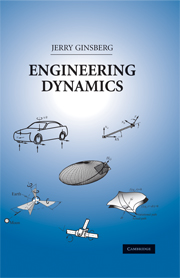Book contents
- Frontmatter
- Contents
- Preface
- Acknowledgments
- 1 Basic Considerations
- 2 Particle Kinematics
- 3 Relative Motion
- 4 Kinematics of Constrained Rigid Bodies
- 5 Inertial Effects for a Rigid Body
- 6 Newton–Euler Equations of Motion
- 7 Introduction to Analytical Mechanics
- 8 Constrained Generalized Coordinates
- 9 Alternative Formulations
- 10 Gyroscopic Effects
- Appendix
- Answers to Selected Homework Problems
- Index
8 - Constrained Generalized Coordinates
Published online by Cambridge University Press: 05 June 2012
- Frontmatter
- Contents
- Preface
- Acknowledgments
- 1 Basic Considerations
- 2 Particle Kinematics
- 3 Relative Motion
- 4 Kinematics of Constrained Rigid Bodies
- 5 Inertial Effects for a Rigid Body
- 6 Newton–Euler Equations of Motion
- 7 Introduction to Analytical Mechanics
- 8 Constrained Generalized Coordinates
- 9 Alternative Formulations
- 10 Gyroscopic Effects
- Appendix
- Answers to Selected Homework Problems
- Index
Summary
The basic development of Lagrange's equations in the preceding chapter is suitable for many important engineering applications. However, up to now these equations have only been employed when the generalized coordinates constitute an unconstrained set. The first part of this chapter removes this limitation. For nonholonomic systems the use of constrained generalized coordinates is mandatory. However, it might be desirable to use constrained coordinates to analyze holonomic systems, as will be seen. This is the situation when the effect of sliding friction is an important feature, which will be treated in depth.
Regardless of whether one follows the Lagrangian or Newton–Euler approach, derivation of the differential equations of motion is only the first phase of a dynamic analysis. Solution of those equations to simulate a system's response is usually the ultimate objective. As several examples have already demonstrated, the equations of motion can be quite complicated, and therefore not amenable to analytical solution. The basic state-space approach to solving the differential equations of motion associated with holonomic systems was developed in Section 7.6. The occurrence of constraint equations and Lagrange multipliers requires modification of that formulation. The second part of this chapter develops and implements several numerical algorithms that may be used to solve the equations of motion governing constrained generalized coordinates.
LAGRANGE'S EQUATIONS–CONSTRAINED CASE
Lagrange's equations for unconstrained coordinates constitute a set of differential equations of motion whose number equals the number of generalized coordinates.
Information
- Type
- Chapter
- Information
- Engineering Dynamics , pp. 492 - 551Publisher: Cambridge University PressPrint publication year: 2007
